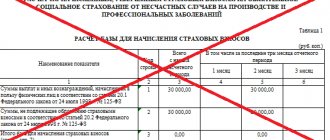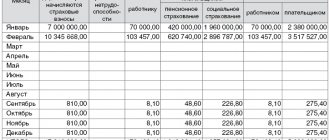The concept of “total difference” was excluded from accounting terminology. All operations falling under this definition began to be called exchange rate differences. This significantly simplified accounting and contributed to the convergence of requirements in accounting and tax accounting.
Question: Is the positive exchange rate difference arising from the intermediary taken into account in non-operating income for profit tax purposes when the principal (principal, principal) reimburses expenses incurred by him (clause 11, article 250 of the Tax Code of the Russian Federation)? View answer
The concept of exchange rate differences
The term exchange rate difference is collective; it includes information about the difference in the cost of one object arising in connection with the valuation in different currencies. If an asset was purchased at a price set in a foreign currency, then the purchase and sale transaction is reflected in the ruble equivalent.
Question: Are positive exchange differences from the revaluation of targeted financing funds (targeted revenues) included in non-operating income for income tax purposes (clause 11 of Article 250 of the Tax Code of the Russian Federation)? View answer
Conversion into national currency units is carried out at the rate approved by the Central Bank of the Russian Federation on the date of fulfillment of the existing obligation. Before the actual acceptance of the object for accounting, time may pass during which the exchange rate value will be updated. The difference between the valuations converted into rubles at the time the obligations arose and the day the asset was placed on the balance sheet will be considered the exchange rate.
FOR REFERENCE! The use of the term exchange rate differences is typical for companies engaged in export-import activities.
The occurrence of differences in valuation is not inherent in all operations. This phenomenon occurs only when the price of the ruble fluctuates. The price of ruble banknotes in relation to other currencies has a direct impact on the discount price. Recalculation must be carried out for all types of assets that are purchased or sold in foreign currency. The norm is enshrined in Art. 271 and 272 of the Tax Code of the Russian Federation.
How do exchange rate differences affect VAT taxation ?
Entries in accounting registers
Accounting for currency transactions is carried out using special registers. Entries in such registers are made in rubles according to the accounting accounts of existing assets and liabilities in foreign currency. It does not matter where exactly the company operates - abroad or in Russia. Entries for accounting for settlements and funds are also made simultaneously in the currency in which settlements were made (accruals of liabilities) or payment was received.
In accounting for transactions with foreign currency, exchange rate differences are reflected separately from other income/expenses, including separately from the financial results obtained from conducting business operations in foreign currency.
Read about the role of currency payments in organizing accounting for export transactions in the material “How to take into account exports in accounting (nuances)?” .
When do exchange differences occur?
Exchange rate differences may arise as a result of the revaluation of currency values, including in bank accounts. The reason for these manipulations may be a change in the official ruble exchange rate. The resulting exchange rate difference can be:
- positive if there is an increase in the value of objects listed on active accounts (for the category of passive accounts the opposite condition is a depreciation);
- negative when the exchange rate decreases in relation to objects for which accounting is kept on active accounts (for the group of passive accounts, one should focus on the increase in the exchange rate).
What are realized and unrealized exchange rate differences?
The fact of recalculating the valuation of an asset into the ruble equivalent can be done with reference to one of the dates:
- crediting money in foreign currency to a bank account;
- debiting resources from a foreign currency bank account;
- receipt of cash in the form of foreign currency to the organization’s cash desk;
- recognition of income receipts denominated in foreign currency;
- the fact of recognition of costs calculated in foreign banknotes;
- reflection in accounting of costs aimed at purchasing inventories;
- recognition of expenses for the service received;
- the moment of approval by the company management of the employee’s advance report, which contains information about costs in foreign currency;
- repayment of a bill in foreign currency.
Question: Who should pay the exchange rate difference when collecting a debt in foreign currency as part of enforcement proceedings? View answer
There is no talk of exchange rate differences if the transfer was made as a full prepayment (or an advance payment of 100% was received). The norm is explained in the Letter of the Ministry of Finance dated June 22, 2015 under No. 03-03-06/1/35865. There is no need to calculate the difference between exchange rate fluctuations in the situation with deposits issued or received.
Currency transactions in case of conducting business abroad
If an enterprise operates abroad, then when preparing financial statements, all assets used and existing liabilities are recalculated into rubles. This also applies to funds held in accounts in foreign banks operating abroad.
Conversion into rubles to reflect foreign exchange transactions in accounting is carried out at the official rate established by the Central Bank for the currency in which assets, liabilities and inventories are recorded. The exception is when recalculation is made at the average rate.
Cash in foreign currency, including in settlements of borrowed obligations, which are used by the organization to conduct business abroad, are converted into rubles at the Central Bank exchange rate in effect on the reporting date. Foreign non-current assets of the company, as well as advances received and sent in connection with activities abroad are recalculated into rubles at the Central Bank exchange rate on the day of the transaction in foreign currency.
If a company has recalculated the value of its foreign assets and liabilities as required by foreign legislation, then this recalculated value is converted into rubles at the rate that was in effect on the date of recalculation.
The difference that arises when converting into rubles the value of assets and liabilities that are used to conduct the company’s foreign activities is reflected in account 83 as additional capital in the accounting of foreign exchange transactions.
The materials in this section will help you understand the intricacies of accounting.
Reflection of exchange rate differences according to the rules of accounting and tax accounting
In accounting, the amount of exchange rate differences is shown as part of other income receipts or other costs. Account 91 is intended for this. An exception is made for the exchange rate difference indicator, the occurrence of which is due to settlements made with the founders and revaluation of the resource base used outside the Russian Federation. In this case, the accounting data contains correspondence not with 91, but with 83 accounts.
When making entries on exchange rate differences in accounting, you must focus on PBU 3/2006. The initial value for calculating the value of exchange rate fluctuations is represented by the exchange rate on the date of the payment made. Debts to suppliers must be revalued at the time of repayment. If the debt transfers to the next month, then it must be converted into ruble equivalent at the end of the month as of its last day.
In tax accounting, all resulting exchange differences must be included in non-operating income or expenses. The recalculation of this indicator with its further reflection in the accounting data is carried out as business transactions are carried out or as of the last day of the reporting interval (month). For assets held in bank foreign currency accounts, recalculation of the valuation must be carried out in each case of exchange rate fluctuations recorded by the Central Bank of the Russian Federation.
NOTE! The calculation of exchange rate differences in accounting and tax accounting is carried out according to general rules.
In tax accounting, non-operating income receipts in the amount of exchange rate differences appear when revaluing assets (goods, claims on counterparties) expressed in foreign currencies (clause 11 of Article 250 of the Tax Code of the Russian Federation). The second source of income generation is the reduction of liabilities calculated in foreign currency. The occurrence of non-operating costs is due to the depreciation of assets and an increase in the share of liabilities (Clause 1, Article 265 of the Tax Code of the Russian Federation).
Exchange differences must be shown on tax return forms. When calculating the taxable amount for VAT linked to the date of shipment of goods (if payment for them is carried out in foreign currency), the conversion of the value into the ruble equivalent must be carried out at the rate of the Central Bank of the Russian Federation. The exchange rate value is taken to be the one recorded at the time of actual unloading of goods at the recipient’s facility. On the day of receipt of payment for delivered products, revaluation is not provided for by law. As a result, exchange rate differences are not generated for VAT purposes. The magnitude of exchange rate differences is significant for income taxes.
IMPORTANT! Exchange differences are not shown in the VAT return, but are necessarily reflected in the profit return in the category of non-operating income and expenses.
Payments in foreign currency and reporting
The statements indicate exclusively the ruble equivalent of the value of the company's assets, existing liabilities and reserves (including those used/located abroad).
If in the country where a Russian company operates, it is required to prepare reports in the currency of that state, then the reports are also prepared in foreign currency.
The financial statements reflect those cost values that are indicated in the accounting. In most cases, the conversion of the currency value into rubles is carried out at the time of the transaction, but there are situations when it is necessary to make a conversion at the reporting date.
The accounting records reveal the amounts of exchange rate differences:
- formed when converting into rubles the currency value of assets and liabilities for which it is required to pay in foreign currency;
- when recalculating the currency value of assets and liabilities for which payment will be made in rubles;
- credited to accounting accounts, which do not take into account financial results.
The official exchange rate in rubles established by the Central Bank on the reporting date is also reflected in the financial statements. If a rate other than the official rate of the Central Bank of the Russian Federation is established (by agreement or law), then this information is also reflected in the reporting.
Find out about the latest changes in currency legislation from this publication.
Postings
Typical correspondence is presented in two options: with debiting (for a negative difference) or crediting (for a positive difference) account 91. In pairs with it, accounts 50, 52, 57, 55, 58, 76, 67, 62, 60, 66 can be recorded If the company has funds in a foreign currency account, it is necessary to re-evaluate the resources whenever the exchange rate of the Central Bank of the Russian Federation changes. Examples of reflecting such transactions in accounting:
- There was an increase in the exchange rate, which led to an increase in the value of the ruble equivalent of foreign currency money in accounts. For the company, the resulting difference is recognized as income. An entry is made in accounting between debit 52 and credit 91.1. Provided that the money was in cash and was at the cash desk at the time of revaluation, it is necessary to debit account 50 rather than 52.
- Fluctuations in the exchange rate downward caused a decrease in the indicator of foreign currency in terms of rubles. The enterprise incurred an expense for the difference in valuation, which is shown by posting D91.2–K52. If the foreign currency was not in bank accounts, but in the organization’s cash desk, then the correspondence will be in the form D91.2–K50.
In relation to materials, fixed assets and other property assets purchased for foreign currency, the cost is fixed on the date the object is accepted for accounting. For reflection in accounting records, the Central Bank exchange rate in effect on the day the property was placed on the balance sheet is used. Changes in the value of assets due to currency fluctuations are not provided for by law (clause 9 of PBU 3/2006). But the revaluation will affect the buyer's outstanding obligations to the supplier:
- D91.2 – K60, if a negative exchange rate difference has formed before the payment;
- D60 – K91.1 – in settlements with the supplier, a positive exchange rate difference was recorded.
Activities for the acquisition of currency associated with the formation of exchange rate differences are shown in accounting by the following correspondence:
- D57 – K51 – there was a transfer of funds allocated for the purchase of foreign currency;
- D52 – K57 – foreign currency resources were converted and transferred to the company’s current account;
- D57 – K91.1 – based on the calculation certificate, a positive exchange rate difference is reflected;
- D91.2 – K57 – according to the data from the calculation certificate, a negative exchange rate difference was recorded.
Similar transactions will be generated during currency sales transactions.
How to take into account exchange rate differences when purchasing fixed assets
The cost of fixed assets expressed in foreign currency is recalculated into rubles on the date of transfer of ownership from the seller to the buyer.
Please note: when purchasing fixed assets on an advance payment basis in foreign currency, there are no exchange differences.
EXAMPLE 3. ACCOUNTING FOR EXCHANGE DIFFERENCES WHEN PURCHASING FIXED ASSETS
Polet LLC purchased a machine worth $6,000 from a foreign supplier.
On February 3 of the reporting year, the company paid for the machine in US dollars. Ownership of the machine transferred to Polet on February 10 of the reporting year. The US dollar exchange rate was: - on February 3 - 24.5 rubles / USD; - on February 10 - 25 rubles ./USD. To simplify the example, we do not consider the calculation of customs duties and taxes. The Polet accountant will make the following entries: February 3 DEBIT 60 CREDIT 52
- 147,000 rubles.
(6000 USD × 24.5 rubles/USD) – prepayment was transferred to the supplier; February 10 DEBIT 08 CREDIT 60
- 147,000 rub.
(6000 USD × 24.5 rubles/USD) – the machine was capitalized on the balance sheet of Polet; DEBIT 01 CREDIT 08
- 147,000 rub. (6000 USD × 24.5 rubles/USD) – the machine is put into operation.
Conclusion
Exchange rate differences in accounting arise in the following cases:
- Changes in the foreign currency exchange rate during the execution of the transaction.
- Translation of assets and liabilities denominated in foreign currencies, excluding shares and advances.
- Buying or selling foreign currency at a rate different from the Central Bank rate.
To calculate income tax, exchange rate differences are taken into account according to the same rules as in accounting. Exchange rate differences do not affect the calculation of VAT.
For the simplified taxation system and unified agricultural tax, it is necessary to take into account only income in the form of positive exchange rate differences that arose during the purchase and sale of currency.
When calculating UTII and the cost of a patent, exchange rate differences are not used.
Example 2
Delta LLC sold goods worth $2,000 with deferred payment to a foreign buyer. On the date of shipment, the dollar exchange rate was 65 rubles, so the company took into account revenue in the amount of 65 x 2000 = 130,000 rubles. On the date of payment, the rate increased to 67 rubles per dollar and the ruble equivalent of the foreign exchange earnings received became equal to 67 x 2000 = 134,000 rubles. A deviation of 4,000 rubles is an additional income for the company, i.e. positive exchange rate difference.
DT 62 – CT 90 (RUB 130,000) – revenue accrued at the exchange rate on the date of shipment
DT 52 – CT 62 (RUB 134,000) – foreign currency earnings are credited to the account at the rate on the date of payment
DT 62 – KT 91.1 (4000 rub.) – positive exchange rate difference
If an organization received or issued an advance in foreign currency, then exchange rate differences do not arise (clause 7 of PBU 3/2006). In this case, revenue or costs are taken into account at the exchange rate on the date of receipt (issue) of the advance. Changes in the exchange rate by the time the advance payment is “closed” by shipment will not affect accounting in any way.








